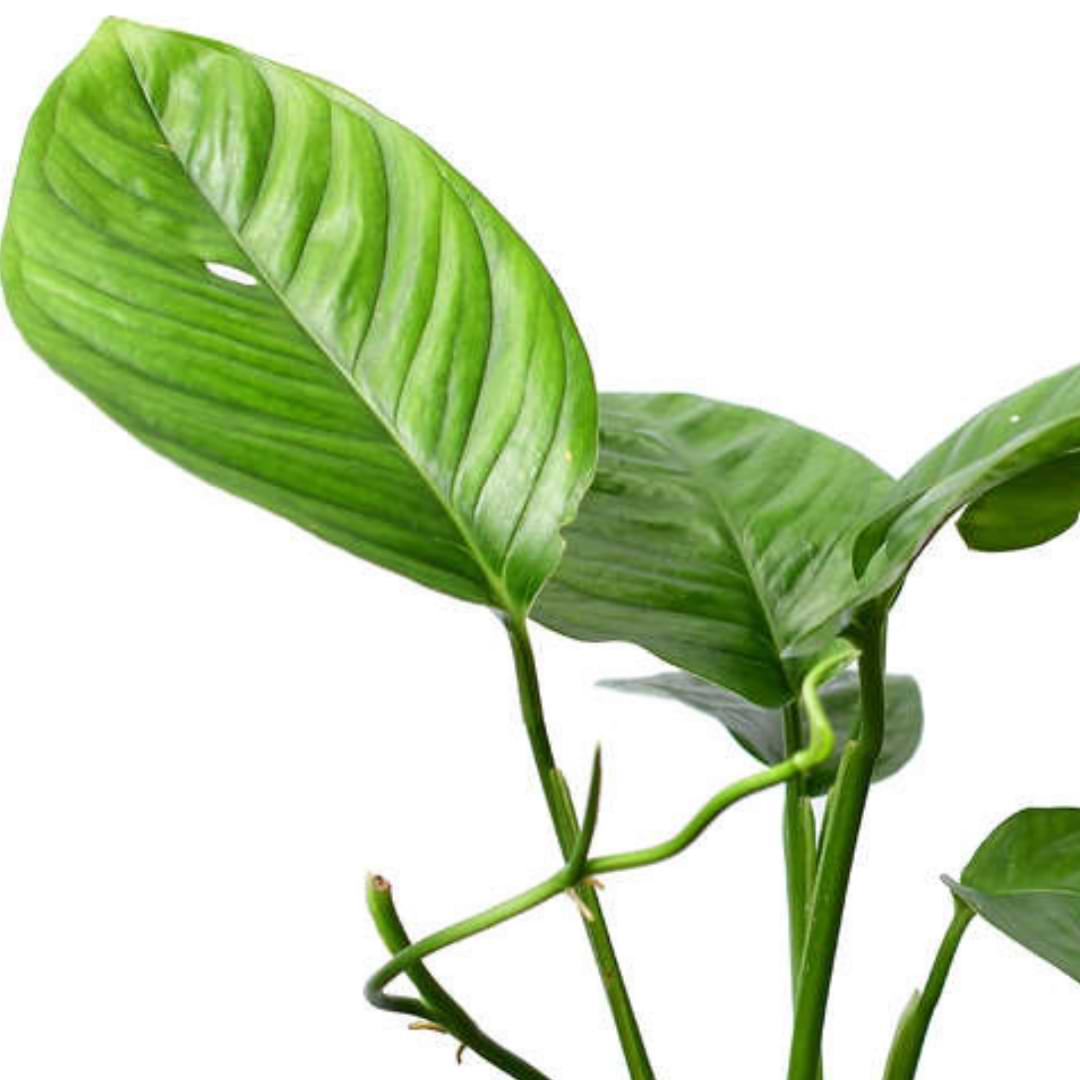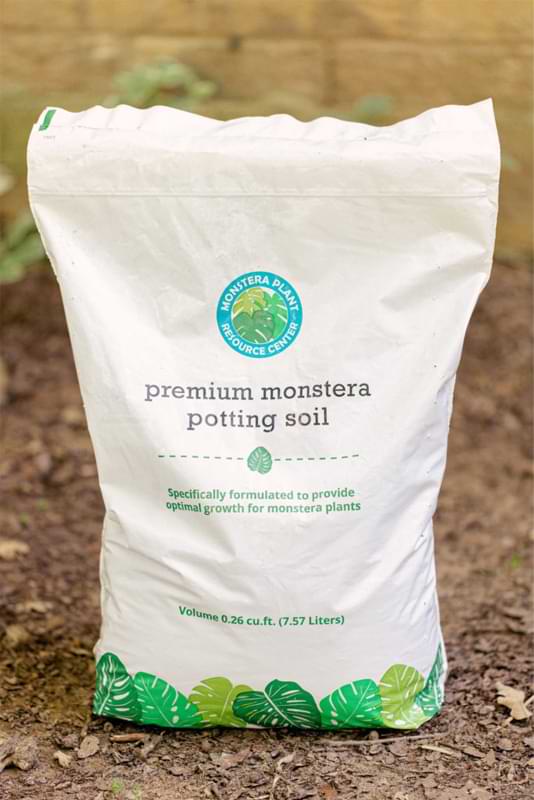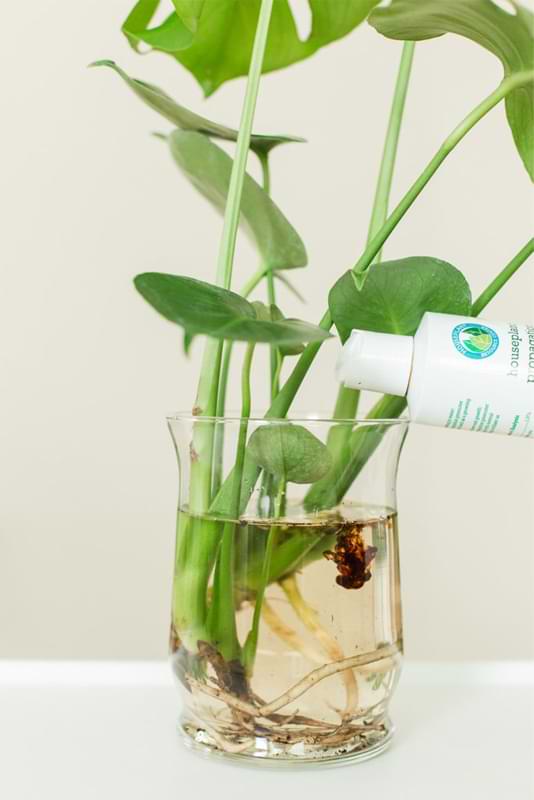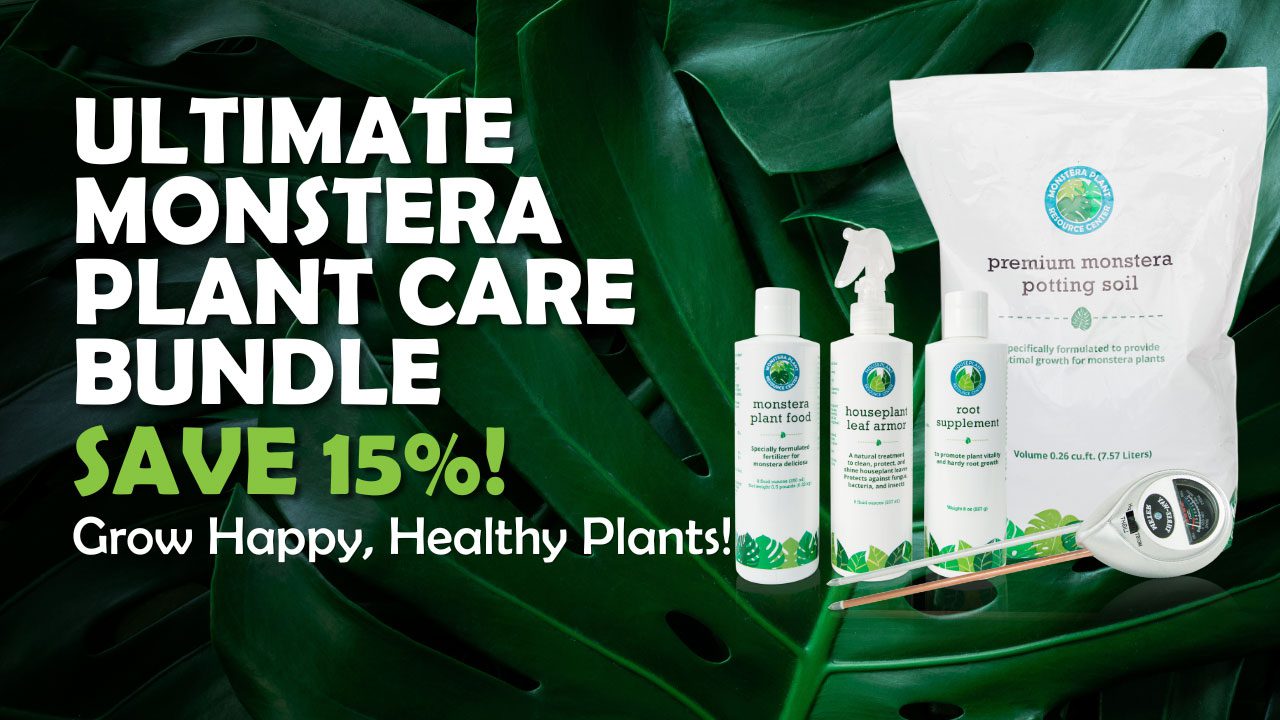Monstera Lechleriana is a beautiful but quite rare monstera variety that’s much sought-after for its beautifully shaped leaves and interesting fenestration pattern. Though this plant is sometimes tricky to find and even trickier to distinguish from its close relative Monstera Adansonii, once you get your hands on one, they’re quite easy to care for and will reward you with stunning leaves with those characteristic monstera holes!
In this article, we’ll cover everything you need to know about Monstera Lechleriana, how to identify it (and distinguish it from adansonii), how to care for it, and what to do if your plant develops health problems.
Here we go!
Table of Contents
How Do You Identify Monstera Lechleriana?
The first step to acquiring and caring for a Monstera Lechleriana is understanding how to identify it. It’s also critical to know how to tell it apart from other similar, more common monstera species.
Here’s how to ID a lechleriana.
Juvenile Plants
A young Monstera Lechleriana may not have any holes at all, which can make it difficult to identify a young plant and tell it apart from other species that don’t fenestrate until later in life, or at all.
The leaves of the juvenile plant are fairly narrow, arrow-shaped, and just a few inches long. It can take a year or more for a young plant to start producing holes, so be patient!
Mature Monstera Lechleriana
A mature Monstera Lechleriana will produce leaves that grow to 10 inches long with rounded holes close to the central rib of the leaf. These plants like to climb and can grow up to 8 feet tall indoors if you give them something to climb, like a moss pole or trellis.
Variegated Monstera Lechleriana
There is such a thing as a variegated Monstera Lechleriana, but they’re extremely rare and very, very expensive. If you are able to locate one, you can expect to pay hundreds or even thousands of dollars for a cutting or a mature plant.
These plants are beautiful and produce white and dark-green variegation in a painterly, marbled fashion that’s absolutely gorgeous. These plants can be harder to keep alive than their non-variegated counterparts, however. While the coloring is lovely, the lack of chlorophyll (the substance that gives plants their green coloring and that is primarily responsible for photosynthesis) can mean the plant needs more sunlight to create enough energy, but also makes the leaves more photosensitive and less tolerant to direct sunlight. Getting the lighting conditions right can be a delicate dance!
If you decide you’re up to the challenge, set up your eBay search alerts and keep a close eye on Etsy in case one becomes available!
Monstera Adansonii vs. Lechleriana
Monstera Lechleriana can be hard to differentiate from the popular Monstera Adansonii. It’s even common for one to be mislabeled as the other in gardening stores or even online retailers.
There are a few ways to tell the difference, though. If possible, it’s easiest to distinguish the two if you have them side by side, but that might not be possible.
Here are some things to look for when you’re trying to solve the “lechleriana or adansonii” mystery:
- The holes on lechleriana leaves are usually rounder, closer to the central rib, and fewer in number than those of adansonii. Up to ⅓ of an adansonii leaf can easily be taken up by holes, but lechleriana leaves tend to be much more solid leaf than hole.
- Monstera lechleriana leaves are usually larger than adansonii leaves. Mature adansonii leaves generally reach 4 or 5 inches long, while the leaves of a mature Monstera Lechleriana can grow up to 10 inches long.
- Adansonii plants tend to grow more leaves and have a more bushy appearance, while lechleriana plants will look more vine-y.
- Lechleriana leaves are usually thicker and even a bit leathery, while adansonii leaves are thinner and more delicate.
- This isn’t something you can pick up on while you’re comparing plants at your local plant boutique, but it’s worth noting: Monstera Adansonii usually grows faster than Monstera Lechleriana. This also means that lechleriana requires less water and fertilizer. That might be something to consider when deciding between the two (that is, if you don’t plan on adding both to your collection).
Is Monstera Lechleriana Rare?
While Monstera Lechleriana isn’t as common as the classic Monstera Deliciosa, Monstera Dubia, or even Monstera Adansonii, it’s not too hard to find. They may pop up from time to time in your local gardening center (sometimes mislabeled as adansonii, so look closely!), and you should be able to find one online without too much trouble.
Monstera Lechleriana Care Guide
So once you get your Monstera Lechleriana, how do you take care of it?
Here’s everything you need to know!
Position
These plants thrive in bright light, but definitely don’t tolerate direct sunlight, as the leaves are prone to scorching and discoloring in full sun.
An east-facing window is the best place for your Monstera Lechleriana because it should get plenty of bright light all day, but no more than a little bit of direct sun in the morning before 9:00 a.m.
A south- or west-facing window might also be a good place if you filter the sunlight with a sheer curtain or a cloth, or even scoot the plant back far enough so that it still gets lots of light, but no direct sun blasting right on the leaves.
A north-facing window might not provide enough light for your plant to grow and thrive, but you can try it if the window is big enough.
If necessary, you can also supplement with a full-spectrum grow light like these bulbs that you can screw into regular light fixtures.
Sufficient light is crucial for producing those coveted fenestrations, so make sure to get this part right!
Humidity and Temperature
These plants tolerate most typical indoor temperatures and humidity levels. As long as you keep the temps between 60-85 degrees Fahrenheit and the humidity level around 40%, you should be good!
If you live in a very arid climate and need to provide a little extra humidity to keep your lechleriana happy, you can set up a humidifier nearby, place your plant in a bathroom or kitchen (these tend to be the most humid areas of the house), group it with other plants (this creates some extra humidity as the plants respirate, plus it looks nice!), or you can place a smaller plant on a pebble tray. Just don’t let the leaves, roots, or soil touch the water!
Make sure to avoid placing your plant near drafty doors and windows, heaters, fireplaces, and air-conditioning or heating vents, which can quickly freeze, scorch, or dry out your plant’s leaves. Not good!
Also, keep in mind that an environment that’s too dry or cold will also prevent the plant from producing holes. Just sayin’.
Water
These plants can handle drier conditions than many other monstera species thanks to their thicker leaves, but you still don’t want to let them dry out!
Water your plant when the top 3-4 inches of soil feel dry to the touch, or when a moisture meter reads about a 2. (We’re big fans of moisture meters, by the way, because they give you a more accurate idea of the moisture level of the root ball.)
When it’s time to water, add water to the soil until it drains out the bottom so that all the potting mix gets nice and soaked. Then let it drain completely.
Instead of watering on a schedule, we recommend keeping an eye on the soil and taking cues from your plant to know when to water.
For a healthy plant with well-draining soil, you should be watering every 7-10 days.
Soil Conditions
Monstera plants like chunky, peaty, well-aerated soil that drains quickly.
Regular cactus mix with some extra peat moss and perlite mixed in can work in a pinch, but we recommend making your own potting mix or buying a soil especially made for monstera plants.
If you choose the DIY route, this aroid soil recipe from Kaylee Ellen’s YouTube channel is amazing:
- 5 parts orchid bark
- 4 parts coir
- 5 parts perlite
- 2 parts activated charcoal
- 2 parts worm castings
If you want an easy-button solution, our Premium Monstera Potting Soil was created just for monstera plants (though it works great for other aroids too) and is ready to go right out of the bag!
This soil contains orchid bark, coco coir, perlite, activated charcoal, worm castings, and loamy soil, which perfectly balances moisture retention and drainage to prevent both over- and underwatering. The coir and worm castings also provide plenty of nutrients to give your monstera a jump-start on growth. Finally, this potting mix is the perfect neutral pH level that your monstera prefers.
The best part is that it’s ready to go right out of the bag!
Fertilizing
Your Monstera Lechleriana will most likely experience a growth spurt during the spring and summer months, so this is when it will need the most nutrients. Though as a slower-growing monstera species, it may not need as much fertilizer as some other, hungrier varieties (we’re looking at you, Monstera Deliciosa).
During the spring and summer, fertilize your Monstera Lechleriana twice a month or so with a gentle liquid fertilizer designed for aroids. Our Monstera Plant Food is the perfect choice because it contains the ideal blend of nitrogen, phosphorus, and potassium to support the growth of healthy foliage and strong roots.
It’s very gentle and easy to use, and you can use it on your other monstera plants and aroids like pothos, philodendron, and peace lilies as well!
Get Monstera Plant Food on Amazon!
Potting and Repotting
This monstera species doesn’t grow as quickly as some other varieties, and therefore won’t need to be repotted as often. However, you may want to repot every year just to refresh the soil and upgrade your pot if necessary. And if you ever notice that your soil has hardened in the pot, or that your lechlariana’s roots are popping out of the top or bottom or growing in a circle around the inside of the pot, it’s time to repot.
To do this, simply tip the pot and use a trowel to lever the root ball out. Don’t pull the plant by its stems, because you could break them.
Once your plant is out of the old pot, massage the root ball to break it up and get some of the old soil out so you can start fresh.
Make sure your new pot isn’t more than 2 or 3 inches larger than your plant’s root ball or it may hold on to more water than your plant needs. The last thing you want is overwatering issues!
Pruning
You may need to prune your Monstera Lechleriana from time to time to remove dying material or control its size and shape.
We suggest planning your cuts in advance because you can’t take them back!
Envision the shape you’re trying to create and mark your planned cuts with string or tape. It’s also a good idea to avoid pruning more than 10% of your plant’s leaves at a time to avoid sending it into shock.
When it’s time to cut, you might want to wear gloves to protect your hands from your monstera’s irritating sap, and maybe keep a towel handy to catch anything that might want to drip onto your floor or furniture. Use sterilized shears or scissors to make your cuts.
If you’re cutting healthy material, don’t throw away those cuttings!
Next, we’ll show you how to turn those cuttings into new Monstera Lechleriana plants.
Propagating Monstera Lechleriana
Monstera Lechleriana is fun and fairly easy to propagate. And there’s no better gift than a propagation from one of your own plants to give as a gift to a plant-loving friend or family member!
You can propagate your plant by rooting cuttings in soil or water, or by air layering.
If you’re taking a cutting, make sure to find at least one healthy, preferably young leaf and a node. Using clean shears, cut just below the node so that your cutting includes a healthy leaf and a node.
Soil
To root your cutting in soil, fill a small container with drainage (like a grower’s pot or a yogurt container with drainage holes punched in the bottom) with potting mix like the ones we described above. Plant your cutting a few inches down, preferably so that it can stand up on its own.
Water thoroughly with a mix of water and Propagation Promoter, then place in a bright, warm place (though not in direct sunlight or near a heater). Keep the soil evenly moist but not soaked. You might also want to cover the whole thing with plastic wrap or a plastic bag to lock in humidity.
Your cutting should start to grow new roots within a few weeks and be ready for a more permanent potting situation in about two months!
Water
To root your cutting in water, place it in a clear glass container of water with a little Propagation Promoter mixed in (this will encourage rooting and discourage infection) so that the cut end is totally submerged but the leaves aren’t touching the water at all. Put the container in a bright place, but remember, no direct sunlight allowed. Keep the water topped off and change it out completely at least once per week.
Within a few weeks, new roots should start to form on the stem. Once the roots are an inch long (this usually takes about 2 months), you can plant the cutting in soil and care for it like you would a mature plant.
Air Layering
So how do you air layer a Monstera Lechleriana? It’s simple!
You’ll need clean scissors or a knife, sphagnum moss (not peat moss), plastic wrap, string or twist ties, and Propagation Promoter and a cotton ball (those last two are optional but recommended).
Locate a node on a healthy, still-growing section of stem near at least one or two healthy leaves. Using the knife or scissors, make a tiny cut about ¼ inch away from the node. Make sure this cut is little, just ¼ through the stem or so, so you don’t accidentally take a cutting! (Though if you do, no worries, just root that baby in water or soil.) It’s really more of a scratch than a cut.
Then dab the wound with a little Propagation Promoter on the cotton ball.
Soak the sphagnum moss and wring it out so that it’s damp but not sopping wet. Then wrap the moss around the wound, and wrap plastic wrap around the moss, loosely securing the whole thing with the string or twist ties.
Loosen the bundle each day and spray down the moss a little bit with water in a spray bottle to keep everything moist but not wet. Roots should start forming near the wound within a few weeks, and after a month or two, that bundle should be full of scraggly roots. Once those roots are an inch long, use clean scissors to cut the whole section off beneath the node so that your new roots are included in the cutting. Plant the cutting in soil and care for it like a grown-up plant!
Common Problems
Monstera Lechleriana is known for being pretty hardy, even for a monstera, thanks to its thick leaves. But it can still develop health problems or fall prey to household pests.
Here are some common warning signs to look for and what to do when your plant starts to exhibit them.
Pests
Household pests like spider mites, mealybugs, brown scale, aphids, and thrips can move into your Monstera Lechleriana and start snacking on the leaves. This can result in a droopy, discolored plant due to all the tiny wounds and a lack of turgor pressure from the lost moisture (pests LOVE to suck the juices out of your monstera’s leaves and stems!).
Signs of insects might include drooping, yellowing, little black, brown, or red spots on the leaves, cottony webbing, sticky clear residue, or, you know, actual insects. If you see any of these signs, act fast!
Treatment for Pests
For most pests, the treatment is twofold: remove as many of the invaders as you can, then follow through with diluted neem oil spray or even an insecticide to keep the bugs from returning.
To remove the insects, use a showerhead or kitchen sprayer to shower the leaves and dislodge the pests. You might want to tip the plant on its side to avoid flushing the insects into the soil. You can also try using a lint roller on the leaves or, in the case of brown scale, pick the insects off with your fingers. (Rubbing alcohol on a cotton swab can also help remove these stubborn pests.)
Then take your plant outside and spray it down with diluted neem oil or Leaf Armor Spray. You might need to do this a few times over a couple of weeks to kill off new generations of insects as they hatch.
It’s also a good idea to keep any infected plants away from your other houseplants so the infestation doesn’t spread!
Brown Tips
This usually indicates that your Monstera Lechleriana needs more humidity! Try the humidity-increasing tips we mentioned above including the humidifier, grouping plants, or a humidity tray. You can also try misting your plant a few times per week. This is most effective when done before 7:00 a.m. and 9:00 a.m., or later in the evening. Make sure to spray the undersides of the leaves as well as the tops because this is where most of the plant’s stomata, or pores, are which allow the plant to absorb the moisture.
If humidity doesn’t seem to be the issue, your plant may be having a reaction to its water. Some plants don’t like the chlorine, fluoride, and other chemicals that are present in some tap waters, so you might want to switch to purified, distilled, or rainwater, or at least start leaving your water out overnight to let the chemicals evaporate before you give it to your monstera.
Drooping Leaves
Drooping is one of those symptoms that can have lots of different causes, and not all of them require your intervention.
Sometimes the issue is simply shock. If you recently moved or repotted your monstera, your plant might just be recovering. If you think this is the issue, leave your plant alone for a while (though still providing your usual care) and let it adjust. It should perk up on its own within a week or two.
Other causes can include underwatering (Is the soil dry? Give your plant a drink!), cold (check for drafts and vents, and adjust your plant’s location accordingly), overwatering (Is your soil soggy long after you watered?), insects (check for the signs above), and sometimes overfertilizing.
Use the process of elimination to pinpoint the cause here. Check out your plant’s environment, the moisture level of the soil, and think about how you’ve been watering and fertilizing your plant. If something seems amiss, make adjustments!
Yellow Leaves
Yellowing leaves on your Monstera Lechleriana can also have many different causes, including overwatering, underwatering, insufficient sunlight, overfertilizing, and underfertilizing. Frustrating, right?
Again, the key here is the process of elimination.
Start by checking the moisture level of the soil. Is it bone-dry, with yellowing leaves all over the plant? Your plant is probably underwatered.
Is it still wet several days after you watered, with yellow leaves mostly on the bottom of the plant? Your monstera is probably overwatered and needs better drainage (or more light).
Is the soil okay but your plant’s area seems a little dark? It might need more light. Especially pay attention to this when the seasons are changing and the sun’s position in the sky shifts. You might need to adjust your plant’s position (or add a grow light) to ensure it gets enough light!
Have you repotted or fertilized your plant recently? If not, and it’s spring or summer, your plant might need nutrients. Start fertilizing a few times per month with Monstera Plant Food to provide the nutrients your plant needs to stay healthy and grow.
Check for other signs of insects like webbing or tiny dots. If you find anything, follow our recommendations for de-bugging your monstera.
Have you been fertilizing and everything else seems okay? Look at the surface of the soil. Is there a white crust there? That might be mineral buildup from an excess of fertilizer.
Here’s how to reverse overfertilization in monsteras.
Monstera Lechleriana: Final Thoughts
Monstera Lechleriana is a gorgeous monstera variety that should have a place in any houseplant lover’s collection. It’s easy to care for and adds a beautiful flush of greenery to any space. And the unusual fenestration pattern is fascinating!
Give one of these lovely tropical plants a try!
For more monstera resources, be sure to check out our helpful community on Facebook.







